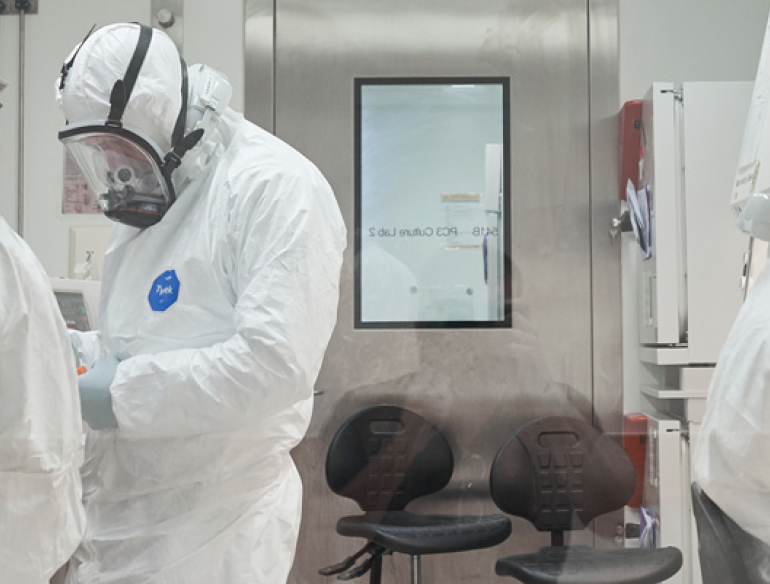A team of researchers from the Kirby Institute and UNSW Sydney have today released preliminary data on the Omicron variant. The findings have been uploaded to a pre-print server and are yet to be peer-reviewed by independent experts.
Led by Associate Professor Stuart Turville, the researchers measured a substantial decrease in the antibody response among 16 samples from vaccinated people (8 AstraZeneca, 8 Pfizer).
The ‘fold’ decrease refers a drop in antibodies binding to and blocking the virus. The fold decrease measured by the Kirby Institute team ranged from 15 to 20 depending on the population sampled.
“Neither vaccination with two doses of AstraZeneca nor Pfizer were able to stimulate an antibody response strong enough to neutralise Omicron in our assays among the samples we tested. This is significant and supports the need for boosters to protect from infection,” says A/Prof Turville.
The Kirby Institute team are also the first globally to measure the immune response to Omicron using a pooled clinical grade hyper-immune IgG (HIGG) product, which is plasma from thousands of donors who’ve developed antibodies through either natural infection and/or vaccination.
They found an 11-13 fold reduction in antibodies from the high titre recent Ig concentrate batches (containing a mixture of vaccinated, convalescent and non-convalescent US donors as well as an Ig concentrate batch produced in 2020 from convalescent US/EU donors only).
“This product is very useful as it is a good indicator of immunity to COVID-19 in the broader global community and includes plasma from people who have been exposed to a number of pre-Delta variants,” explains A/Prof Turville. “Testing against a variety of different populations or products and generating similar results generates increased confidence in our findings.”
Lab studies vs real world implications
Director of the Kirby Institute, Professor Anthony Kelleher, says that neutralisation in the lab is important but is very different to prevention of infection and disease in the real world.
“Studies like this are important parts in understanding the Omicron puzzle, but it will be some time before we know exactly what this will mean in clinical practice,” he says.
“Other levels of immunity such as immune memory in T cells still need to be considered in terms of protection from severe disease. As observed with many other variants, the vaccine response may not fully protect people from becoming infected, but importantly, it will reduce the chance of developing severe disease,” he says.
A/Prof Turville says that based on this preliminary data, viral control of Omicron will need to be achieved in a very different way in Australia.
“Even among vaccinated populations it is likely that Omicron will take over as the dominant variant. We should expect to see significant community spread. Day by day we’ll know more, but for now, people should follow government advice on boosters, social distance, wear masks where appropriate and follow the public health orders.”
Early data supports boosters
Dr Deborah Cromer and her colleagues at the Kirby Institute have been collecting available early data on Omicron neutralisation and have used a mathematical model developed earlier this year to predict the efficacy of vaccines to the new variant.
Their meta-analysis of four early studies shows that a booster dose with an existing mRNA vaccine has the potential to raise efficacy for Omicron to 86.2% against symptomatic infection and 98.2% against severe disease.
“While our research shows that primary vaccination is not as effective against Omicron as it is against the original COVID-19 strain, the evidence is showing that a booster dose with an mRNA vaccine, irrespective of the type of initial vaccination, is highly effective against Omicron,” says Dr Cromer.
“The main takeaway from our analysis is for people to get a booster dose as soon as they are able to.”
Isolating then testing omicron quickly
The Kirby Institute researchers isolated Omicron from the first patient diagnosed in Australia and for the past fortnight, they have been testing the variant's capacity to evade antibodies that are generated during the vaccine response.
The team used methodology previously developed in collaboration with the Garvan Institute to rapidly sequence the virus. They simultaneously use cells specifically engineered to capture virus and then rapidly characterise it.
“In these genetically developed cells, the virus replicates four times faster than through any other techniques currently published in the scientific literature,” A/Prof Turville says.
Contact
Luci Bamford, Media and Communications Manager, Kirby Institute
Phone
0432 894 029
Header Image
L-R: Dr Anupriya Aggarwal, Dr Alberto Ospina Stella, and Associate Professor Stuart Turville working inside Kirby Institute’s PC3 containment lab. Image: Kirby Institute/UNSW – Richard Freeman
